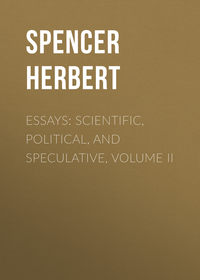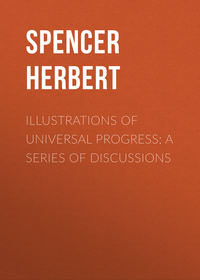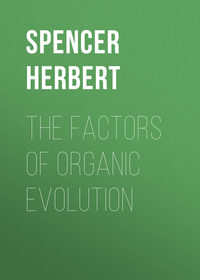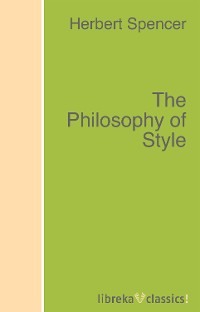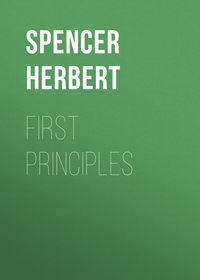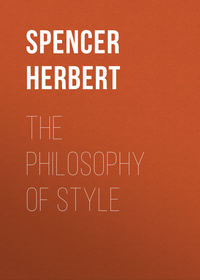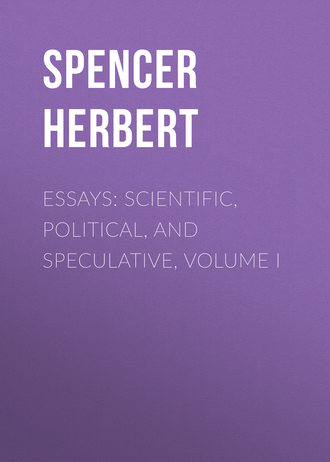 полная версия
полная версияEssays: Scientific, Political, and Speculative, Volume I
Space permitting, we might show how the localization o£ special industries in special parts of a kingdom, as well as the minute subdivision of labour in the making of each commodity, are similarly determined. Or, turning to a somewhat different order of illustrations, we might dwell on the multitudinous changes – material, intellectual, moral, – caused by printing; or the further extensive series of changes wrought by gunpowder. But leaving the intermediate phases of social development, let us take a few illustrations from its most recent and its passing phases. To trace the effects of steam-power, in its manifold applications to mining, navigation, and manufactures of all kinds, would carry us into unmanageable detail. Let us confine ourselves to the latest embodiment of steam power – the locomotive engine. This, as the proximate cause of our railway system, has changed the face of the country, the course of trade, and the habits of the people. Consider, first, the complicated sets of changes that precede the making of every railway – the provisional arrangements, the meetings, the registration, the trial section, the parliamentary survey, the lithographed plans, the books of reference, the local deposits and notices, the application to Parliament, the passing Standing Orders Committee, the first, second, and third readings: each of which brief heads indicates a multiplicity of transactions, and the extra development of sundry occupations – as those of engineers, surveyors, lithographers, parliamentary agents, share-brokers; and the creation of sundry others – as those of traffic-takers, reference-takers. Consider, next, the yet more marked changes implied in railway construction – the cuttings, embankings, tunnellings, diversions of roads; the building of bridges and stations, the laying down of ballast, sleepers, and rails; the making of engines, tenders, carriages, and waggons: which processes, acting on numerous trades, increase the importation of timber, the quarrying of stone, the manufacture of iron, the mining of coal, the burning of bricks; institute a variety of special manufactures weekly advertised in the Railway Times; and, finally, open the way to sundry new occupations, as those of drivers, stokers, cleaners, plate-layers, &c., &c. And then consider the changes, still more numerous and involved, which railways in action produce on the community at large. Business agencies are established where previously they would not have paid; goods are obtained from remote wholesale houses instead of near retail ones; and commodities are used which distance once rendered inaccessible. Again, the diminished cost of carriage tends to specialize more than ever the industries of different districts – to confine each manufacture to the parts in which, from local advantages, it can be best carried on. Further, the fall in freights, facilitating distribution, equalizes prices, and also, on the average, lowers prices: thus bringing divers articles within the means of those before unable to buy them, and so increasing their comforts and improving their habits. At the same time the practice of travelling is immensely extended. People who never before dreamed of it, take trips to the sea; visit their distant relations; make tours; and so we are benefited in body, feelings, and ideas. The more prompt transmission of letters and of news produces other marked changes – makes the pulse of the nation faster. Once more, there arises a wide dissemination of cheap literature through railway book-stalls, and of advertisements in railway carriages: both of them aiding ulterior progress. And the countless changes here briefly indicated are consequent on the invention of the locomotive engine. The social organism has been rendered more heterogeneous in virtue of the many new occupations introduced, and the many old ones further specialized; prices of nearly all things in every place have been altered; each trader has modified his way of doing business; and every person has been affected in his actions, thoughts, emotions.
Illustrations to the same effect might be indefinitely accumulated, but they are needless. The only further fact demanding notice, is, that we here see still more clearly the truth before pointed out, that in proportion as the area on which any force expends itself becomes heterogeneous, the results are in a yet higher degree multiplied in number and kind. While among the simple tribes to whom it was first known, caoutchouc caused but few changes, among ourselves the changes have been so many and varied that the history of them occupies a volume.5 Upon the small, homogeneous community inhabiting one of the Hebrides, the electric telegraph would produce, were it used, scarcely any results; but in England the results it produces are multitudinous. The comparatively simple organization under which our ancestors lived five centuries ago, could have undergone but few modifications from an event like the recent one at Canton; but now, the legislative decision respecting it sets up many hundreds of complex modifications, each of which will be the parent of numerous future ones.
Space permitting, we could willingly have pursued the argument in relation to all the subtler results of civilization. As before we showed that the law of progress to which the organic and inorganic worlds conform, is also conformed to by Language, the plastic arts, Music, &c.; so might we here show that the cause which we have hitherto found to determine progress holds in these cases also. Instances might be given proving how, in Science, an advance of one division presently advances other divisions – how Astronomy has been immensely forwarded by discoveries in Optics, while other optical discoveries have initiated Microscopic Anatomy, and greatly aided the growth of Physiology – how Chemistry has indirectly increased our knowledge of Electricity, Magnetism, Biology, Geology – how Electricity has reacted on Chemistry and Magnetism, and has developed our views of Light and Heat. In Literature the same truth might be exhibited in the manifold effects of the primitive mystery-play, as originating the modern drama, which has variously branched; or in the still multiplying forms of periodical literature which have descended from the first newspaper, and which have severally acted and reacted on other forms of literature and on each other. The influence which a new school of Painting – as that of the pre-Raphaelites – exercises upon other schools; the hints which all kinds of pictorial art are deriving from Photography; the complex results of new critical doctrines, as those of Mr. Ruskin, might severally be dwelt upon as displaying the like multiplication of effects.
But we venture to think our case is already made out. The imperfections of statement which brevity has necessitated, do not, we believe, invalidate the propositions laid down. The qualifications here and there demanded would not, if made, affect the inferences. Though, in tracing the genesis of progress, we have frequently spoken of complex causes as if they were simple ones; it still remains true that such causes are far less complex than their results. Detailed criticisms do not affect our main position. Endless facts go to show that every kind of progress is from the homogeneous to the heterogeneous; and that it is so because each change is followed by many changes. And it is significant that where the facts are most accessible and abundant, there these truths are most manifest.
However, to avoid committing ourselves to more than is yet proved, we must be content with saying that such are the law and the cause of all progress that is known to us. Should the Nebular Hypothesis ever be established, then it will become manifest that the Universe at large, like every organism, was once homogeneous; that as a whole, and in every detail, it has unceasingly advanced towards greater heterogeneity. It will be seen that as in each event of to-day, so from the beginning, the decomposition of every expended force into several forces has been perpetually producing a higher complication; that the increase of heterogeneity so brought about is still going on and must continue to go on; and that thus progress is not an accident, not a thing within human control, but a beneficent necessity.
A few words must be added on the ontological bearings of our argument. Probably not a few will conclude that here is an attempted solution of the great questions with which Philosophy in all ages has perplexed itself. Let none thus deceive themselves. After all that has been said, the ultimate mystery remains just as it was. The explanation of that which is explicable, does but bring out into greater clearness the inexplicableness of that which remains behind. Little as it seems to do so, fearless inquiry tends continually to give a firmer basis to all true Religion. The timid sectarian, obliged to abandon one by one the superstitions bequeathed to him, and daily finding his cherished beliefs more and more shaken, secretly fears that all things may some day be explained; and has a corresponding dread of Science: thus evincing the profoundest of all infidelity – the fear lest the truth be bad. On the other hand, the sincere man of science, content to follow wherever the evidence leads him, becomes by each new inquiry more profoundly convinced that the Universe is an insoluble problem. Alike in the external and the internal worlds, he sees himself in the midst of ceaseless changes, of which he can discover neither beginning nor end. If, tracing back the evolution of things, he allows himself to entertain the hypothesis that all matter once existed in a diffused form, he finds it impossible to conceive how this came to be so; and equally, if he speculates on the future, he can assign no limit to the grand succession of phenomena ever unfolding themselves before him. Similarly, if he looks inward, he perceives that both terminations of the thread of consciousness are beyond his grasp: he cannot remember when or how consciousness commenced, and he cannot examine the consciousness at any moment existing; for only a state of consciousness which is already past can become the object of thought, and never one which is passing. When, again, he turns from the succession of phenomena, external or internal, to their essential nature, he is equally at fault. Though he may succeed in resolving all properties of objects into manifestations of force, he is not thereby enabled to conceive what force is; but finds, on the contrary, that the more he thinks about it, the more he is baffled. Similarly, though analysis of mental actions may finally bring him down to sensations as the original materials out of which all thought is woven, he is none the forwarder; for he cannot in the least comprehend sensation. Inward and outward things he thus discovers to be alike inscrutable in their ultimate genesis and nature. He sees that the Materialist and Spiritualist controversy is a mere war of words; the disputants being equally absurd – each believing he understands that which it is impossible for any man to understand. In all directions his investigations eventually bring him face to face with the unknowable; and he ever more clearly perceives it to be the unknowable. He learns at once the greatness and the littleness of human intellect – its power in dealing with all that comes within the range of experience; its impotence in dealing with all that transcends experience. He feels more vividly than any others can feel, the utter incomprehensibleness of the simplest fact, considered in itself. He alone truly sees that absolute knowledge is impossible. He alone knows that under all things there lies an impenetrable mystery.
TRANSCENDENTAL PHYSIOLOGY
[First published in The National Review for October, 1857, under the title of "The Ultimate Laws of Physiology". The title "Transcendental Physiology", which the editor did not approve, was restored when the essay was re-published with others in 1857.]
The title Transcendental Anatomy is used to distinguish that division of biological science which treats, not of the structures of individual organisms considered separately, but of the general principles of structure common to vast and varied groups of organisms, – the unity of plan discernible throughout multitudinous species, genera, and orders, which differ widely in appearance. And here, under the head of Transcendental Physiology, we purpose putting together sundry laws of development and function which hold not of particular kinds or classes of organisms, but of all organisms: laws, some of which have not, we believe, been hitherto enunciated.
By way of unobtrusively introducing the general reader to biological truths of this class, let us begin by noticing one or two with which he is familiar. Take first, the relation between the activity of an organ and its growth. This is a universal relation. It holds, not only of a bone, a muscle, a nerve, an organ of sense, a mental faculty; but of every gland, every viscus, every element of the body. It is seen, not in man only, but in each animal which affords us adequate opportunity of tracing it. Always providing that the performance of function is not so excessive as to produce disorder, or to exceed the repairing powers either of the system at large or of the particular agencies by which nutriment is brought to the organ, – always providing this, it is a law of organized bodies that, other things equal, development varies as function. On this law are based all maxims and methods of right education, intellectual, moral, and physical; and when statesmen are wise enough to see it, this law will be found to underlie all right legislation.
Another truth co-extensive with the organic world, is that of hereditary transmission. It is not, as commonly supposed, that hereditary transmission is exemplified merely in re-appearance of the family peculiarities displayed by immediate or remote progenitors. Nor does the law of hereditary transmission comprehend only such more general facts as that modified plants or animals become the parents of permanent varieties; and that new kinds of potatoes, new breeds of sheep, new races of men, have been thus originated. These are but minor exemplifications of the law. Understood in its entirety, the law is that each plant or animal produces others of like kind with itself: the likeness of kind consisting not so much in the repetition of individual traits as in the assumption of the same general structure. This truth has been made by daily illustration so familiar as nearly to have lost its significance. That wheat produces wheat, – that existing oxen are descended from ancestral oxen, – that every unfolding organism ultimately takes the form of the class, order, genus, and species from which it sprang; is a fact which, by force of repetition, has assumed in our minds the character of a necessity. It is in this, however, that the law of hereditary transmission is principally displayed; the phenomena commonly named as exemplifying it being quite subordinate manifestations. And the law, as thus understood, is universal. Not forgetting the apparent, but only apparent, exceptions presented by the strange class of phenomena known as "alternate generation," the truth that like produces like is common to all types of organisms.
Let us take next a universal physiological law of a less conspicuous kind. To the ordinary observer, it seems that the multiplication of organisms proceeds in various ways. He sees that the young of the higher animals when born resemble their parents; that birds lay eggs, which they foster and hatch; that fish deposit spawn and leave it. Among plants, he finds that while in some cases new individuals grow from seeds only, in other cases they also grow from tubers; that by certain plants layers are sent out, take root, and develop new individuals; and that many plants can be reproduced from cuttings. Further, in the mould that quickly covers stale food, and the infusoria that soon swarm in water exposed to air and light, he sees a mode of generation which, seeming inexplicable, he is apt to consider "spontaneous." The reader of popular science thinks the modes of reproduction still more various. He learns that whole tribes of creatures multiply by gemmation – by a development from the body of the parent of buds which, after unfolding into the parental form, separate and lead independent lives. Concerning microscopic forms of both animal and vegetal life, he reads that the ordinary mode of multiplication is by spontaneous fission – a splitting up of the original individual into two or more individuals, which by and by severally repeat the process. Still more remarkable are the cases in which, as in the Aphis, an egg gives rise to an imperfect female, from which other imperfect females are born viviparously, grow, and in their turns bear other imperfect females; and so on for eight, ten, or more generations, until finally, perfect males and females are viviparously produced. But now under all these, and many more, modified modes of multiplication, the physiologist finds complete uniformity. The starting-point, not only of every higher animal or plant, but of every clan of organisms which by fission or gemmation have sprung from a single organism, is always a spore, seed, or ovum. The millions of infusoria or of aphides which, by sub-division or gemmation, have proceeded from one individual; the countless plants which have been successively propagated from one original plant by cuttings or tubers; are, in common with the highest creature, primarily descended from a fertilized germ. And in all cases – in the humblest alga as in the oak, in the protozoon as in the mammal – this fertilized germ results from the union of the contents of two cells. Whether, as among the lowest forms of life, these two cells are seemingly identical in nature; or whether, as among higher forms, they are distinguishable into sperm-cell and germ-cell; it remains throughout true that from their combination results the mass out of which is evolved a new organism or new series of organisms. That this law is without exception we are not prepared to say; for in the case of the Aphis certain experiments are thought to imply that under special conditions the descendants of an original individual may continue multiplying for ever, without further fecundation. But we know of no case where it actually is so; for although there are certain plants of which the seeds have never been seen, it is more probable that our observations are in fault than that these plants are exceptions. And until we find undoubted exceptions, the above-stated induction must stand. Here, then, we have another of the truths of Transcendental Physiology: a truth which, so far as we know, transcends all distinctions of genus, order, class, kingdom, and applies to every living thing.
Yet another generalization of like universality expresses the process of organic development. To the ordinary observer there seems no unity in this. No obvious parallelism exists between the unfolding of a plant and the unfolding of an animal. There is no manifest similarity between the development of a mammal, which proceeds without break from its first to its last stage, and that of an insect, which is divided into strongly-marked stages – egg, larva, pupa, imago. Nevertheless it is now an established fact, that all organisms are evolved after one general method. At the outset the germ of every plant or animal is relatively homogeneous; and advance towards maturity is advance towards greater heterogeneity. Each organized thing commences as an almost structureless mass, and reaches its ultimate complexity by the establishment of distinctions upon distinctions, – by the divergence of tissues from tissues and organs from organs. Here, then, we have yet another biological law of transcendent generality.
Having thus recognized the scope of Transcendental Physiology as presented in its leading truths, we are prepared for the considerations that are to follow.
And first, returning to the last of the great generalizations above given, let us inquire more nearly how this change from the homogeneous to the heterogeneous is carried on. Usually it is said to result from successive differentiations. This, however, cannot be considered a complete account of the process. During the evolution of an organism there occur, not only separations of parts, but coalescences of parts. There is not only segregation, but aggregation. The heart, at first a simple pulsating blood-vessel, by and by twists upon itself and becomes integrated. The bile-cells constituting the rudimentary liver, do not merely diverge from the surface of the intestine in which they at first form a simple layer; but they simultaneously consolidate into a definite organ. And the gradual concentration seen in these and other cases is a part of the developmental process – a part which, though more or less recognized by Milne-Edwards and others, does not seem to have been included as an essential element in it.
This progressive integration, manifest alike when tracing up the several stages passed through by every embryo, and when ascending from the lower organic forms to the higher, may be most conveniently studied under several heads. Let us consider first what may be called longitudinal integration.
The lower Annulosa– worms, myriapods, &c. – are characterized by the great numbers of segments of which they respectively consist, reaching in some cases to several hundreds; but as we advance to the higher Annulosa– centipedes, crustaceans, insects, spiders, – we find these numbers greatly reduced, down to twenty-two, thirteen, and even fewer; and accompanying this there is a shortening or integration of the whole body, reaching its extreme in crabs and spiders. Similarly with the development of an individual crustacean or insect. The thorax of a lobster, which, in the adult, forms, with the head, one compact box containing the viscera, is made up by the union of a number of segments which in the embryo were separable. The thirteen distinct divisions seen in the body of a caterpillar, become further integrated in the butterfly: several segments are consolidated to form the thorax, and the abdominal segments are more aggregated than they originally were. The like truth is seen when we pass to the internal organs. In the lower annulose forms, and in the larvæ of the higher ones, the alimentary canal consists either of a tube that is uniform from end to end, or else bulges into a succession of stomachs, one to each segment; but in the developed forms there is a single well-defined stomach. In the nervous, vascular, and respiratory systems a parallel concentration may be traced. Again, in the development of the Vertebrata we have sundry examples of longitudinal integration. The coalescence of several segmental groups of bones to form the skull is one instance of it. It is further illustrated in the os coccygis, which results from the fusion of a number of caudal vertebræ. And in the consolidation of the sacral vertebræ of a bird it is also well exemplified.
That which we may distinguish as transverse integration, is well illustrated among the Annulosa in the development of the nervous system. Leaving out those simple forms which do not present distinct ganglia, it is to be observed that the lower annulose animals, in common with the larvæ of the higher, are severally characterized by a double chain of ganglia running from end to end of the body; while in the more advanced annulose animals this double chain becomes a single chain. Mr. Newport has described the course of this concentration in insects; and by Rathke it has been traced in crustaceans. In the early stages of the Astacus fluviatilis, or common cray-fish, there is a pair of separate ganglia to each ring. Of the fourteen pairs belonging to the head and thorax, the three pairs in advance of the mouth consolidate into one mass to form the brain, or cephalic ganglion. Meanwhile out of the remainder, the first six pairs severally unite in the median line, while the rest remain more or less separate. Of these six double ganglia thus formed, the anterior four coalesce into one mass; the remaining two coalesce into another mass; and then these two masses coalesce into one. Here we see longitudinal and transverse integration going on simultaneously; and in the highest crustaceans they are both carried still further. The Vertebrata exhibit this transverse integration in the development of the generative system. The lowest of the mammalia – the Monotremata– in common with birds, have oviducts which towards their lower extremities are dilated into cavities severally performing in an imperfect way the function of a uterus. "In the Marsupialia, there is a closer approximation of the two lateral sets of organs on the median line; for the oviducts converge towards one another and meet (without coalescing) on the median line; so that their uterine dilatations are in contact with each other, forming a true 'double uterus.' … As we ascend the series of 'placental' mammals, we find the lateral coalescence becoming gradually more and more complete… In many of the Rodentia, the uterus still remains completely divided into two lateral halves; whilst in others, these coalesce at their lower portion, forming a rudiment of the true 'body' of the uterus in the Human subject. This part increases at the expense of the lateral 'cornua' in the higher Herbivora and Carnivora; but even in the lower Quadrumana, the uterus is somewhat cleft at its summit."6 And this process of transverse integration, which is still more striking when observed in its details, is accompanied by parallel though less important changes in the opposite sex. Once more; in the increasing commissural connexion of the cerebral hemispheres, which, though separate in the lower vertebrata, become gradually more united in the higher, we have another instance. And further ones of a different order, but of like general implication, are supplied by the vascular system.


